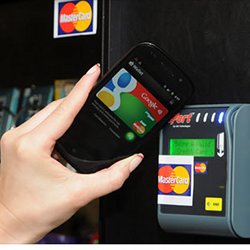
It is taking Americans a bit longer than the rest of the world to catch on to the idea of “mobile wallets.” But, by 2020, it is likely U.S. consumers will be making online and store payments by swiping a smart device, according to 65% of 1,021 technology experts and stakeholders recently surveyed by Elon University’s Imagining the Internet Center and the Pew Research Center’s Internet & American Life Project.
What is slowing the transition are hurdles such as a lack of infrastructure to support adoption throughout the country, and privacy fears, say 33% of poll respondents.
“Lack of infrastructure is perhaps the biggest hurdle and it’s become a chicken-and-egg problem,” says Denée Carrington, senior analyst at Forrester Research. “Merchants have been reluctant to invest in POS [point of sale] systems that are NFC-capable without sufficient demand, and handset manufacturers have had little incentive to invest in NFC-enabled handsets without sufficient POS usage opportunities.”
The second-highest hurdle has been resistance from consumers who may not see a clear benefit in mobile wallets.
“Many people have just gotten around to transitioning from cash to credit cards,” says Bob Frankston, a respondent to the Pew survey, an ACM Fellow, and co-developer of VisiCalc. “What’s the advantage to using a smart device over a credit card?”
Also, Frankston says, consumers have security perception issues with mobile payments–the third highest hurdle.
According to Gartner research vice president Christophe Uzureau, a recent Gartner survey revealed that–on a scale of 1 (not concerned) to 7 (extremely concerned)–58% of respondents rated as “6 or greater” their fear about someone being able to steal their payment information that is transmitted when making a mobile wallet payment.
“These fears are not unfounded,” says Stessa Cohen, research director at Gartner. “Every day we see some report of problems involving mobile phones; it’s just not clear that they are secure.”
Consumers also need to get used to the idea of making active banking transactions on their phones.
“Today, 90% of mobile banking consists of people checking their bank balances,” says Cohen. “That’s not what I’d call a very active banking transaction. The leap to suddenly trusting your mobile phone to enable you to make payments, that’s a big step. You don’t wake up one day and decide to stop using your credit cards and start using your smart phone instead. What’s going to convince you to do that? Only some sort of incentive and it’s not obvious today what that incentive might be.”
According to comScore’s latest report on the topic released in February, 2011, while the use of mobile wallets is starting to gain traction across parts of the globe, Japan is still one of the pioneering markets with 9.8 million mobile users. Of those, 7.6 million used their mobile wallets in retail stores in December, 2010, followed by 3.2 million at vending machines, 2.7 million for public transportation, 2.6 million in grocery stores, and 1.5 million in restaurants.
Although in its infancy in the U.S. and Europe, mobile wallet capabilities are beginning to come onto the scene, says comScore. For instance, in early 2011, Starbucks announced customers in thousands of locations can now pay for items with their phones via an app that can be scanned across a reader at checkout.
“Expect more announcements like this to occur in the next year as brands begin offering this type of mobile payment option,” says comScore. “As we’ve seen in Japan, nearly 10% of its mobile population uses this capability across a variety of transaction locations, perhaps offering a glimpse into the future potential of mobile wallet payments in the U.S. and Europe.”
Paul Hyman is a science and technology writer based in Great Neck, NY.



Join the Discussion (0)
Become a Member or Sign In to Post a Comment